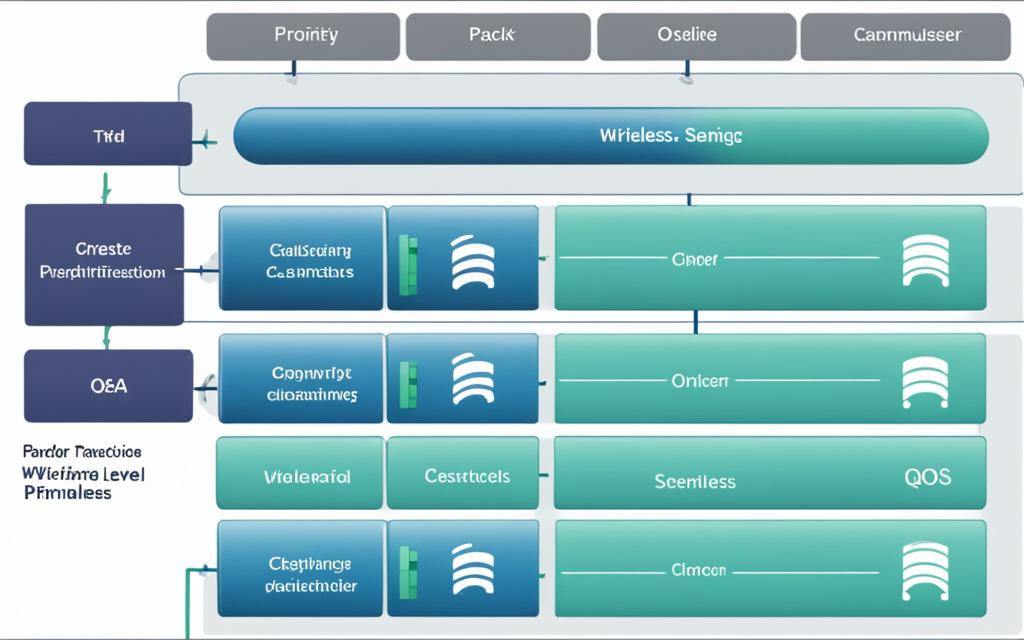Quality of Service (QoS) plays a crucial role in optimizing network performance and improving user experience in wireless local area networks (WLANs). By implementing QoS techniques, organizations can prioritize and allocate network resources to different types of traffic, such as voice, video, and data. This section will explore the best practices for implementing QoS in WLANs to enhance performance and optimize overall network efficiency.
Implementing QoS in WLANs is essential for WLAN performance optimization. By properly configuring QoS settings, organizations can ensure that critical traffic, like voice and video, receives the necessary network resources and priority. This translates to improved call quality, smoother video streaming, and faster data transfers.
In this section, we will dive into the details of QoS configuration, QoS standards and features, and the impact of QoS on WLANs. We will provide expert guidance on QoS implementation best practices, ensuring that organizations can effectively leverage QoS to enhance WLAN performance and deliver an exceptional wireless experience to users.
Understanding QoS for Wireless LANs
Quality of Service (QoS) is a vital component of maximizing performance and ensuring a seamless user experience in wireless local area networks (WLANs). In the context of WLANs, QoS refers to a collection of mechanisms and protocols that enable the prioritization, classification, and control of traffic based on various priority levels. By understanding the intricacies of QoS mechanisms, organizations can effectively implement QoS in their WLAN environments and optimize network performance.
Traffic Classification and Priority Levels
One of the key aspects of QoS in WLANs is traffic classification, which involves identifying different types of traffic and assigning them specific priority levels. By classifying traffic, WLANs can ensure that important applications, such as voice and video, receive the necessary network resources and are prioritized over less critical traffic, such as data transfers. Classification typically relies on various criteria, including but not limited to:
- Protocol type
- Quality of Service (QoS) markings
- Source and destination IP addresses
- Port numbers
Once traffic has been classified, WLANs can then apply specific QoS mechanisms to handle the different priority levels effectively.
Congestion Control and QoS Mechanisms
Congestion control is a critical aspect of QoS for WLANs. It ensures that network resources are appropriately allocated and prevents network congestion, which can lead to degraded performance and user dissatisfaction. QoS mechanisms play a crucial role in managing congestion by regulating and prioritizing traffic in WLANs. Some common QoS mechanisms used for congestion control include:
- Queue management algorithms
- Packet scheduling algorithms
- Bandwidth allocation techniques
- Priority-based access control mechanisms
These mechanisms work in harmony to ensure that traffic flows smoothly and that important applications receive the necessary resources, even during periods of high network activity.
Quote:
“Implementing QoS in wireless LANs allows organizations to optimize resource allocation, ensuring that mission-critical applications receive the necessary network performance while maintaining overall network efficiency.” – [Author Name]
The diagram above illustrates the flow of traffic in a wireless LAN environment with QoS mechanisms in place. By classifying and prioritizing traffic based on different applications and traffic types, QoS enables efficient utilization of network resources.
| QoS Mechanism | Description |
|---|---|
| Traffic Classification | Identifies and differentiates traffic based on various parameters, which allows for the prioritization and allocation of resources. |
| Quality of Service Markings | Enables the marking of packets with specific QoS requirements to ensure proper handling and prioritization throughout the network. |
| Packet Scheduling | Prioritizes packets based on their designated priority levels to manage congestion and ensure fair resource allocation. |
| Bandwidth Control | Regulates and limits the amount of bandwidth available to specific applications or traffic types to prevent network congestion. |
These QoS mechanisms work together to enhance overall WLAN performance, manage congestion, and prioritize critical traffic.
By understanding the fundamentals of QoS for wireless LANs, organizations can effectively configure and optimize their WLAN environments, providing a seamless user experience and maximizing network performance.
Configuring QoS in WLANs
Configuring Quality of Service (QoS) in wireless local area networks (WLANs) is essential for optimizing network performance and ensuring a consistent user experience. By implementing QoS policies and properly configuring VLANs, Ethernet, and radio ports, organizations can prioritize and allocate network resources to different types of traffic. This section provides a step-by-step guide on how to configure QoS in WLANs and explores best practices for optimizing network performance.
Step 1: VLAN Configuration
One of the first steps in configuring QoS in WLANs is to set up VLANs. VLANs allow for the logical separation of traffic, enabling better control and prioritization of different types of data. To configure VLANs for QoS, follow these steps:
- Access the WLAN controller or management interface.
- Create the necessary VLANs and assign them to the appropriate interfaces.
- Configure VLAN tagging, if required, to ensure proper traffic separation.
- Verify VLAN configuration and ensure that all VLANs are correctly associated with the respective interfaces.
Step 2: QoS Policy Configuration
Once VLANs are properly configured, the next step is to create and apply QoS policies. QoS policies define the rules and parameters for traffic prioritization, packet classification, and queuing mechanisms. Follow these steps to configure QoS policies:
- Identify the different types of traffic that need to be prioritized, such as voice, video, or data.
- Define traffic classification criteria, such as source/destination IP address, port numbers, or protocol type.
- Assign appropriate priority levels to each traffic classification.
- Configure queuing mechanisms, such as strict priority or weighted fair queuing, based on the network requirements.
- Apply the QoS policies to the VLANs and interfaces where the traffic originates or passes through.
Step 3: QoS Parameter Settings
Configuring QoS parameters is crucial for optimizing network performance and ensuring a consistent user experience. Consider the following parameters when configuring QoS in WLANs:
- Traffic Prioritization: Set appropriate priority levels for different types of traffic based on their importance.
- Packet Classification: Define rules to classify packets into different traffic categories based on their characteristics.
- Queuing Mechanisms: Configure queuing algorithms to manage the order in which packets are transmitted.
By setting these QoS parameters correctly, organizations can ensure that critical traffic receives priority treatment, minimizing latency and packet loss for time-sensitive applications.
Here is an example of how QoS policies can be applied to different VLANs in WLANs:
| VLAN | QoS Policy |
|---|---|
| VLAN 10 (Voice) | Priority Queuing (PQ) with strict priority |
| VLAN 20 (Video) | Weighted Fair Queuing (WFQ) |
| VLAN 30 (Data) | Weighted Fair Queuing (WFQ) |
This table illustrates the different QoS policies applied to each VLAN, where voice traffic receives priority queuing (PQ) using strict priority, while video and data traffic are managed using weighted fair queuing (WFQ) to ensure fair allocation of resources.
By following these steps and best practices, organizations can effectively configure QoS in WLANs, improving network performance, and providing a seamless user experience.

QoS Configuration Examples
In this section, we will explore practical examples of Quality of Service (QoS) configuration in wireless local area networks (WLANs). These examples will provide real-world scenarios to help organizations understand how to effectively configure QoS in their WLAN environments.
One important aspect of QoS configuration is prioritizing traffic based on its type and application requirements. By assigning specific parameters to different types of traffic, organizations can ensure that critical applications receive the necessary bandwidth and resources.
Example 1: QoS Configuration for VLANs
In a network environment with multiple VLANs, it is essential to configure QoS settings to prioritize traffic within each VLAN. By assigning different Quality of Service Code Point (QoS DSCP) values, organizations can prioritize certain VLANs over others, ensuring that critical applications within these VLANs receive appropriate QoS treatment.
Example 2: IP DSCP and IP Precedence
IP DSCP and IP Precedence are methods for classifying and marking IP packets to indicate their priority. By configuring QoS parameters based on these values, organizations can ensure that high-priority traffic, such as voice or video, receives preferred treatment over lower-priority traffic, like data.
Example 3: VLAN QoS Configuration
VLAN QoS configuration involves configuring QoS settings specific to VLANs. By defining VLAN-specific QoS policies, organizations can allocate and manage bandwidth more effectively within each VLAN, optimizing network performance and ensuring a consistent user experience.
In summary, QoS configuration in WLANs requires careful consideration of various factors, including VLANs, IP DSCP, and IP Precedence. These examples illustrate how organizations can implement QoS principles and parameters in real-world scenarios to optimize WLAN performance and enhance user experience.
Challenges of QoS in High-Density WLAN Environments
Implementing Quality of Service (QoS) in high-density WLAN environments presents organizations with unique challenges. These challenges can significantly impact network performance and the overall user experience. By understanding and addressing these challenges, organizations can optimize QoS implementation and ensure smooth wireless connectivity. This section will discuss the key challenges associated with QoS in high-density WLAN environments.
1. Increased Contention and Collision Probability
In high-density WLAN environments, the number of wireless devices competing for limited network resources is significantly higher. This increased contention and collision probability can lead to performance degradation, increased latency, and poor throughput. Organizations must prioritize QoS to mitigate these issues and ensure fair allocation of resources to different types of traffic.
2. Compatibility and Interoperability
High-density WLAN environments typically involve a diverse range of devices, applications, and vendors. Ensuring compatibility and interoperability between these different components is essential for effective QoS implementation. Organizations may encounter challenges in achieving seamless integration and collaboration between devices and applications from various vendors.
3. Complexity and Variability of the Network Environment
High-density WLAN environments are often characterized by complex and variable network environments. Factors such as building structures, user mobility, and interference from neighboring networks can introduce variability and unpredictability, making QoS implementation more challenging. Organizations must account for these variables and strategically configure QoS parameters to ensure optimal performance in a dynamic network environment.
To overcome these challenges, organizations should adopt best practices for QoS implementation and consider leveraging advanced technologies and solutions that offer intelligent traffic management, adaptive resource allocation, and dynamic network optimization. By addressing these challenges, organizations can enhance network performance, reliability, and user satisfaction in high-density WLAN environments.
| Challenges | Solutions |
|---|---|
| Increased contention and collision probability | Implement traffic prioritization and resource allocation techniques to minimize conflicts and ensure fair resource utilization. |
| Compatibility and interoperability | Thoroughly test and validate the compatibility and interoperability of devices and applications before deployment. |
| Complexity and variability of the network environment | Utilize intelligent network management tools and technologies to dynamically adapt QoS parameters based on the changing network conditions. |
Best Practices for QoS in High-Density WLAN Environments
To optimize your Quality of Service (QoS) in high-density WLAN environments, it is essential to follow best practices that will enhance WLAN performance and ensure a consistent and reliable user experience. By implementing the following strategies, organizations can optimize their WLANs for improved performance and user satisfaction:
1. Centralized Management Platforms
Utilize centralized management platforms that provide a comprehensive view of your WLAN infrastructure. These platforms enable efficient configuration, monitoring, and troubleshooting, allowing you to maintain control over your network performance. With a centralized management system, you can streamline QoS implementation, making it easier to optimize your WLAN for optimal traffic prioritization and resource allocation.
2. Radio Resource Management (RRM) Features
Make use of RRM features, such as dynamic channel selection and load balancing. These features automatically adjust the channel selection and distribution of clients across access points, optimizing the utilization of available resources and minimizing interference. By leveraging RRM features, you can ensure a balanced distribution of traffic, enhancing WLAN performance and minimizing congestion.
3. Traffic Shaping and Bandwidth Management Tools
Implement traffic shaping and bandwidth management tools to regulate network traffic and allocate resources based on priority levels. These tools allow you to control and shape the flow of different types of traffic, ensuring critical applications receive the necessary bandwidth while preventing non-essential traffic from consuming excessive resources. By implementing traffic shaping and bandwidth management, you can maintain consistent QoS levels for essential applications, resulting in an optimized user experience.
“By following these best practices, organizations can enhance WLAN performance and ensure a consistent and reliable user experience.”
Implementing these best practices for QoS in high-density WLAN environments will lead to improved WLAN performance, optimized resource allocation, and an enhanced user experience. By utilizing centralized management platforms, leveraging RRM features, and implementing traffic shaping and bandwidth management, organizations can achieve the highest levels of QoS and create a reliable and efficient wireless network.
| Benefits | Best Practices |
|---|---|
| Enhanced WLAN performance | Utilize centralized management platforms |
| Optimized resource allocation | Leverage RRM features |
| Consistent and reliable user experience | Implement traffic shaping and bandwidth management tools |
WLAN QoS Testing and Validation
Testing and validating WLAN QoS implementation is critical to ensure its effectiveness. By utilizing appropriate methods and tools, organizations can verify the successful implementation of Quality of Service (QoS) in their WLAN environments. This section will explore various techniques for testing and validating WLAN QoS, ensuring optimal network performance and user experience.
Network Analyzers and Packet Capture Tools
Network analyzers and packet capture tools are invaluable resources for monitoring QoS parameters in WLANs. They enable organizations to analyze network traffic, capture packets, and evaluate the performance of QoS mechanisms. By examining captured packets, network administrators can identify and address any issues related to QoS configuration.
Quality of Experience (QoE) Tools
QoE tools play a crucial role in measuring and evaluating QoS metrics from a user’s perspective. These tools assess factors such as latency, jitter, and packet loss, providing valuable insights into the quality of service experienced by end-users. By utilizing QoE tools, organizations can identify potential performance bottlenecks and fine-tune their QoS implementation accordingly.
Network Simulation or Emulation Tools
Network simulation and emulation tools allow organizations to recreate real-world scenarios in controlled environments. By simulating different network conditions, organizations can evaluate the impact of QoS mechanisms on various types of traffic. These tools enable thorough testing of QoS configuration, ensuring its effectiveness and compatibility with different network scenarios.
Network Auditing and Compliance Tools
Network auditing and compliance tools aid in ensuring the consistency and adherence of QoS configuration across the network. These tools perform comprehensive audits to identify any deviations or non-compliance with established QoS policies. By utilizing network auditing tools, organizations can maintain a consistent QoS implementation and address any potential issues in a timely manner.
Through thorough testing and validation of WLAN QoS, organizations can optimize network performance, enhance user experience, and ensure the successful implementation of QoS mechanisms. By leveraging network analyzers, QoE tools, network simulation, and network auditing tools, organizations can confidently deploy QoS in their WLAN environments.
Conclusion
In conclusion, implementing Quality of Service (QoS) in wireless local area networks (WLANs) is vital for enhancing network performance and optimizing the user experience. This article has provided an in-depth exploration of QoS implementation best practices, including QoS configuration, standards and features, testing and validation, and the challenges and solutions for high-density WLAN environments. By following these guidelines and adopting the recommended best practices, organizations can optimize WLAN performance, ensure reliable network connectivity, and elevate the wireless experience for their users.
Implementing QoS in WLANs involves configuring QoS policies and applying them to VLAN and device interfaces. Traffic prioritization, packet classification, and queuing mechanisms should be carefully set to optimize network performance. Practical examples have been provided to illustrate QoS configuration scenarios for VLANs, IP DSCP, and IP Precedence settings.
Challenges in high-density WLAN environments, such as increased contention probability and interoperability issues, must be addressed to ensure effective QoS implementation. Best practices, including centralized management platforms, Radio Resource Management (RRM) features, and traffic shaping tools, have been recommended to overcome these challenges and optimize QoS in high-density WLANs.
Testing and validation are crucial for ensuring the effectiveness of WLAN QoS implementation. Network analyzers, QoE tools, and network simulation or emulation tools can be used to monitor QoS parameters, evaluate QoS metrics, and simulate real-world scenarios. Network auditing and compliance tools are also essential for maintaining consistent and compliant QoS configuration across the network.
FAQ
What is QoS in WLANs?
Quality of Service (QoS) in WLANs refers to the implementation of techniques to prioritize and allocate network resources to different types of traffic, such as voice, video, and data, in order to enhance network performance and improve user experience.
What are the QoS mechanisms for wireless LANs?
QoS mechanisms for wireless LANs include traffic classification, marking, and scheduling based on priority levels defined by IEEE 802.11 standards. These mechanisms help ensure efficient allocation of network resources for different types of traffic.
How do you configure QoS in WLANs?
To configure QoS in WLANs, you need to set up QoS policies and apply them to VLAN and device interfaces. This involves configuring VLANs, setting QoS parameters for traffic prioritization and packet classification, and implementing queuing mechanisms for optimal network performance.
Can you provide examples of QoS configuration in WLANs?
Yes, some examples of QoS configuration in WLANs include setting up QoS for VLANs and configuring IP DSCP and IP Precedence. These examples demonstrate how to apply QoS principles and parameters in real-world scenarios.
What challenges are associated with implementing QoS in high-density WLAN environments?
Implementing QoS in high-density WLAN environments can pose challenges such as increased contention and collision probability, compatibility and interoperability issues, and network complexity and variability.
What are the best practices for implementing QoS in high-density WLAN environments?
Best practices for implementing QoS in high-density WLAN environments include adopting centralized management platforms, utilizing Radio Resource Management (RRM) features for optimal channel selection and load balancing, and employing traffic shaping and bandwidth management tools.
How do you test and validate WLAN QoS implementation?
Testing and validating WLAN QoS implementation involves using network analyzers and packet capture tools to monitor QoS parameters, Quality of Experience (QoE) tools to measure and evaluate QoS metrics, and network simulation or emulation tools to simulate real-world scenarios. Network auditing and compliance tools are also important for ensuring consistent and compliant QoS configuration.



















